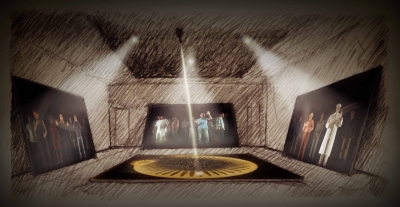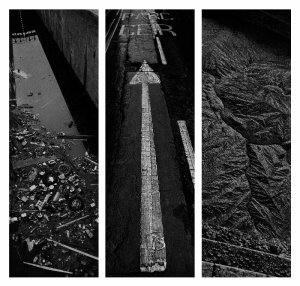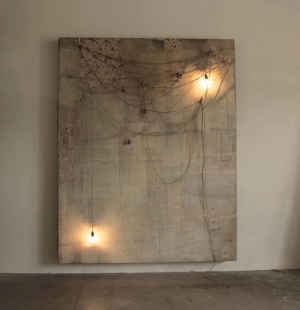The work made for the Holy See’s Pavilion looks at the moment of Creation. This is a sensorial space of 120m2 with the title In Principio (e poi), [tr. In the beginning (and then)] designed specifically for the Venice exhibition. The work looks at the theme of biblical narration through a space that evokes a solid mass of stone which opens up. Within it, immaterial images come to life when touched by the hands of visitors, suggesting the animal and vegetable kingdoms, through the gestures of the deaf and dumb, and the dominion of the spoken word. Human beings are seen as “bringers of stories”, of personal narrations that come together through multimedia languages to form a great story of the origins of the relation between man and space and time. These are voices, faces and gestures living an enclosed condition under space and language, telling stories: male and female prisoners from Milano-Bollate retell their genealogies in an identity building process that moves backwards as far as memory stretches. The viewers relate with the “bearers of stories” and activates, thereby, their own history, overcoming the formal dimensions of representation to immerse themselves in the concept of origin, revitalising them, or extracting forms, creatures and sounds from the movements of their hands and the language of signs of other “bearers of stories”. Thus the extraordinary ability of Studio Azzurro emerges again, showing why they have become over the last three decades one of the most appreciated artistic groups in the world: they know how to fuse physical space and narrative space with imagination, using technology to produce active awareness shared through the open context of the sensorial, to make the creative potentials emerge for whomsoever comes into contact with their work.
The Art on Display
"CREATION"

"Un-CREAtION"

The panoramic format landscapes, which Koudelka began focusing on from the late 1980s show desolation and abandonment but also symbolic power and the ability to excite a perceptive disorientation due to the dimensional wastes, generating images of great evocative power. It is in the sphere of these experiences that the work Uncreation takes form, a sequence of 18 photographs including 9 ink prints of a large horizontal format (cm 91 x 257) and three vertical triptychs (cm 158 x 150). The sequence, elaborated by Koudelka for this occasion, shows a series of images, some of which are famous, others less well known. There are classics of his vision and new works that interpret the power of man’s transformation on the environment and also some very destructive aspects of both nature and of time. Captured with the help of a panoramic camera, sometimes placed together in triptychs, the images witness Koudelka’s extraordinary compositional instincts. Interacting and dialoguing between each other, each image, almost replying in turn to the others, tells of three great themes of destruction: the intervention of time on human history, the environment, and abandonment by man; the sceneries of war, where the silence of what remains after conflict is highlighted; and finally, the two antithetical axes of nature and the industrial world, long engaged in another type of painful and damaging conflict. The chosen photographs cover a period of time which goes from 1986 to 2012 and a vast geographic extension that includes Europe and the near East, from France to Jordan, from Libya to Slovakia, from Germany to Greece.
"RE-CREAtION"

The work realised for the Holy See Pavilion looks at the moment of the Recreation. Placed at the end of the visitor’s path, the installation has the title Another Life, created especially for the theme proposed and this space of the pavilion, it is composed of four great wall paintings and a floor piece, as the author himself defines them. Illumination is of primary importance in the work and is thought of as natural as possible, never aimed directly at the work, but spread equally from the roof, to allow the natural and fine colours that Carroll uses, to use fully their powers of absorbance, accentuated also by the use of wax and oils, components that are dear to the artist for their dense transparency. Even the progectual aspect is a key to this work. It has involved a group of technicians in realising one of the panels on a wall, a freezing painting, unique in its kind for the characteristics and dimensions with respect to his previous works. It cyclically will melt and refreeze modifying its aspect over the course of the day. The operative component for the realisation, in part carried out in the great study near Bolsena, has included a reflection of the artist on the sensations of waiting, of challenge and of joy, as also some implications in the processes of automatism that are unleashed by the “experience of the hands”.
